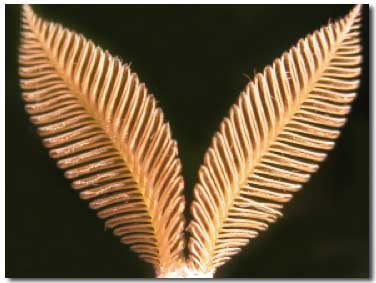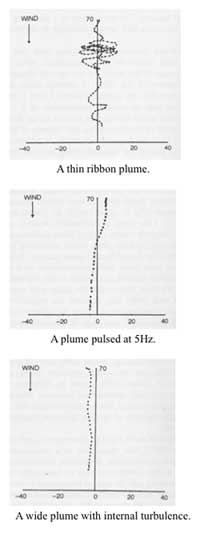Olfactory orientation
Part 2: Behavioural mechanisms – taxis and kinesis
Odour cues/stimuli contain 2 elements of information: odour identity and odour concentration. The temporal component of the stimulus is how these two elements vary in time, and the spatial component how they vary in space. If an odour is a mixture, its identity can change if the composition changes. Insects may use either the spatial or temporal properties of an odour stimulus to locate its source.
Odour-induced orientation behaviour can be categorized on the basis of the way the stimulus is sampled and the other sensory modalities involved (after Kennedy JS (1986) Some current issues in orientation to odour sources, pp 11-26 in Mechanisms in Insect Olfaction (TL Payne, MC Birch & CEJ Kennedy, eds) Clarendon Press, Oxford).
Category |
Stimulus Sampling |
Behavioural Output |
Steering |
|---|---|---|---|
Ortho-kinesis |
Temporal, along path |
Change in linear speed or frequency of flight |
Self-steering |
Klino-kinesis |
Temporal, along path |
Change in rate or frequency of turning |
Self-steering |
Klino-taxis |
Tenporal, small swings left & right |
Moving toward the more or less stimulated side |
By odour gradient |
Tropo-taxis |
Spatially, left & right simultaneously |
Moving toward the more or less stimilated side |
By odour gradient |
Temporal, along path or zig-zag flight |
Upwind flight |
Visual |
Kineses relate to changes in speed or turning whilst moving and indirectly lead to the stimulus source; taxes result in changes to direction and a more direct approach. Often, olfactory orientation is accomplished using a combination of behaviours.
For flying insects, the main effect of an odour stimulus, such as volatile chemicals contained in an odour plume, appears to be as a switch that triggers anemotaxis. Upwind flight is achieved then by visual steering so that the insect maintains a certain airborne position in relation to the ground pattern below. The exact path of a flying insect towards the source of an odour depends on the strategy it uses to deal with the changing environment of an odour plume.
This short video shows the changing spatial and temporal character of an odour plume. A plume may consist of several strands. This video was taken in a wind-tunnel and uses titanium tetrachloride combined with an odour to visualize the plume. |
Aim and shoot strategy:
An insect in contact with a substrate can detect the direction of wind using mechanoreceptors. If an odour activates take-off, the insect can maintain an upwind setting so long as the surrounding visual cues remain informative. If the odour stimulus is lost, the insect lands and waits until it re-contacts with the stimulus. Tsetse flies use this strategy.
For flying insects, the main effect of an odour stimulus, such as volatile chemicals contained in an odour plume, appears to be as a switch that triggers anemotaxis. An insect in flight cannot gauge wind direction using mechanoreceptors. Upwind flight is achieved then by visual steering, so that the insect maintains a certain airborne position in relation to the ground pattern below. To progress upwind, an insect must fly faster than the wind speed and this is accomplished by keeping the longitudinal component of the ground image flow constant. Once initiated, the maintenance of anemotaxis does not appear to require frequent exposure to the odour stimulus. Anemotaxis was first demonstrated in mosquitoes. Closer to the host, visual and temperature stimuli also help to locate a landing site.
 Male moths fly upwind in a straight or zig-zag manner in response to detecting pheromone blends that closely approximate the ratio of sex pheromone compounds emitted by their conspecific females. The activation properties of insect ORNs are in tune with the physical properties of odour strands including pockets of clean air that occur in natural odour plumes due to turbulence. It is the intermittency of stimulation from the plume strands that promotes sustained upwind flight.
Male moths fly upwind in a straight or zig-zag manner in response to detecting pheromone blends that closely approximate the ratio of sex pheromone compounds emitted by their conspecific females. The activation properties of insect ORNs are in tune with the physical properties of odour strands including pockets of clean air that occur in natural odour plumes due to turbulence. It is the intermittency of stimulation from the plume strands that promotes sustained upwind flight.
Such sustained attraction and source location is based on reiterative upwind surges in response to odour strands. Orientation and source contact is optimal when males discriminate the “correct” pheromone blend sufficiently rapidly in each of the pheromone plume strands they contact. Hence, the performance of insect ORNs is optimized for fast, repetitive responses to ensure accurate odour identification of strands arriving irregularly, often in intervals of less than 100 ms, but also with gaps between strands of more than ten times that.
In Heliocoverpa males, pheromone blend-quality evaluations take place on a strand-by-strand basis within fractions of a second. If components of another species’ blend are perceived in a strand, male upwind flight is instantly affected. To do this, most male moths have one more broadly-tuned ORN for other sympatric species’ pheromone components co-compartmentalized with ORNs for their own pheromone in the same sensillum. It is just as crucial for the insect to respond quickly to the pockets of clean air between pheromone strands as it is to respond to the strand itself; a fast switch from upwind flight to cross-wind casting flight is required to increase the chance of recontacting odour-laden air. The biochemical, neurophysiological, and molecular processes that contribute to the propagation of behaviour after contact with airborne pheromone all emphasize high-speed processing related to the temporal resolution of the strand encounters. There is no evidence thus far that male moths need, or use, odour concentration within strands as information to locate females.
Figures to the above left show recorded tracks of Cadra cautella male moths flying upwind in 3 types of pheromone plume in a wind tunnel. Each dot represents 0.03 sec intervals. Scales are in cm.
From Mafra-Neto A, & Carde RT (1994) Fine-scale structure of pheromone plumes modulates upwind orientation of flying moths. Nature 369: 142-144.
This video shows a female moth orientating to a floral odour in a wind tunnel. The moth does not stay at the odour source, probably because it lacks other appropriate visual, taste and tactile cues to distinguish it as a flower. |
 Go on to part 3: Learning and evolution
Go on to part 3: Learning and evolution
Glossary:
anemotaxis an optomotor response, upwind flight that is maintained by visual steering.
klino (Greek) meaning to lean or slope, angle
odour plume A column of volatile molecules moving through air.
ortho (Greek) meaning straight
tropo (Greek) meaning to turn direction

